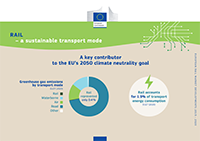In September 2023, the European Commission presented its eighth report on development of the rail market.
While the report gives a high-level overview of the main developments, the full analysis is presented in the accompanying Commission Staff Working Document. Data and figures are also available in an Excel format.

Background
Monitoring the railway markets is necessary in order to inform policy choices, both at EU and national level. Since 2007, the Commission has collected data on rail market developments in Member States via RMMS Questionnaires. The data have been collected based on a 'gentlemen's agreement' which means that gaps in data availability are possible as well as methodological discrepancies. Nevertheless, relatively good response rates have allowed the Commission to publish the RMMS reports every two years since then.
The Recast of the first Rail package (Directive 2014/34/EU) finally created a legal base for RMMS reporting and data harmonisation. It's Article 15 states that the Commission shall make necessary arrangements to monitor technical and economic conditions and market developments in Union rail transport. This must include the use of networks as well as the evolution of framework conditions such as infrastructure charging, capacity allocation, investment in railway infrastructure, prices, quality of services, use of public service contracts, market opening, degree of harmonisation, licensing, employment and related social conditions. The Directive foresaw that the Commission may adopt measures to ensure consistency in the Member States' reporting obligations. The Commission itself shall report every two years to the European Parliament and the Council on the developments in rail markets.
Accordingly, in July 2015, after thorough consultation with Member States and stakeholders, the Commission adopted an implementing Regulation (EU) 2015/1100 on the reporting obligations of the Member States in the framework of rail market monitoring. Since 2016, EU Member States and Norway have been providing input to the Commission’s monitoring of the rail market in line with the format and content defined in the Regulation.
Earlier RMMS Reports:
- The Seventh RMMS report
- The Sixth RMMS Report:
- The Fifth RMMS Report:
- The Fourth RMMS Report:
- The Third RMMS Report:
- The Second RMMS Report:
- The First RMMS Report
